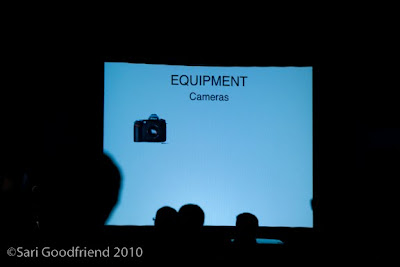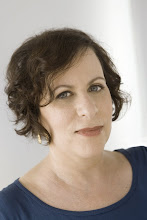
Monday night was the free,
ASMP commercial portfolio review and there was quite a turnout of both reviewers and photographers. I enjoy doing reviews as it gives me a chance to see new work, and also, hopefully, offer some perspective. I usually see people I know and the entire evening is very enjoyable. That said, it was stranger for me this year than last. I saw fewer photographers (but then I’m not as valuable a commodity as an art buyer or magazine editor), and the noise level really affected me this year. As freelance photo editor
Lindsay Blatt said, “It was really loud in that studio space, and I had a hard time hearing.”
I asked reviewers for their opinions in order to gauge their feelings, and thought I’d also bring you some of their suggestions on how to make it even better next year.
Joe Pritchard, a freelance photo rep said he like the structure and the fact that it was free for members. “What I would like to see is a larger space, as it tends to get very loud and difficult at times to hear people and to focus on what they are talking about and showing you.”
Julie Grahame, editor-in-chief,
aCurator magazine wondered if “we could include a couple of successful photographers as reviewers next year.”
For
Patrick Cunningham of
Photolibrary, “It was fun, enjoyable, and social. Thanks for the candy. I really liked helping both the newbie’s and seasoned professionals. Everybody needs a fresh perspective sometime.”
Photography consultant
Louisa Curtis said, “I think it was perhaps too close to
PPE as there were more portfolio review events at PPE this year. The signs above each chair only said the person's name and not their company – that made it hard to identify people. There were too many reviewers and not enough photographers”
“I know that my colleagues in the corner tables did not get to see as much work as I did,” said
Jessica Moon, senior visual content editor, online specialist,
Scholastic, Inc.
And
Anna G. Dickson, photo editor,
Clear Channel Radio - Digital said, “I thought the event went well, although I did not feel there were enough timers for the reviewers. It was hard to hear the timer and after the very first review, I was on my own with time and I'm SURE that I went over 15 minutes several times.”
Monica Suder, creative coach, consultant and curator, “found the noise level very hard and was hoarse by 9PM.”
Wini Alcorn, business affairs manager, Coca-Cola-
MCCANN ERICKSON,| thought “it would have been helpful to have someone using a BELL for the whole space to time the meetings, instead of individual timers per table. Those were annoying as they went off throughout the event. I think it would also streamline the event to have people all move at the same time to a new table, instead of waiting in lines.”
When asked about the quality of the work they had seen, and if anything was really special,
Anna G. Dickson said, “The overall quality of the work was very good, and most, although not all people seemed open to constructive criticism
Patrick Cunningham: “I was most impressed by I
an Spanier’s portraits and lifestyle, as well as
Bruce Katz’ food images.
Whitney Tressel of
Hearst “loved
Carl Wooley,
Chad Hunt, and
Peter Riesett's work the best.”
Jessica Moon had this to say about what she had seen: “
Ashok Sinha – STUNNING!
James Leynse – Curious, intriguing, wonderful!
Stephen Mallon – lovely.”
Wini Alcorn: “Of the people I met, most of them were very talented. That is a huge step up from other events like these where usually the overall work is mediocre. Loved
Mimi Ko,
Erin Patrice O’Brien and
Chad Springer.
Joe Pritchard felt that “many of the photographers need the support of creative consultants and branding help. I am finding that the photographers are so worried about making money and trying to jump into this so fast that they are not presenting themselves and their work properly. Also as we know photographers are some of the worst when editing there own work.” I would have to agree with that general assertion.
Mike Hartley of
Big Flannel was pretty candid in his assessment, saying, “The quality of the work was on average higher than I expected. I am rarely wowed and was not on this evening. I am falsely of the belief my work sells itself, and so were many of the photographers. We should both being trying harder I think.”
Most of the responding reviewers said socializing with other reviewers was an important aspect of participating.
Wini Alcorn thought, “perhaps a cocktail hour/mixer BEFORE the event starts (in a separate room) for people to say hi and chat before getting down to business would b better. “I also think name tags would be helpful for both photogs and reviewers.”
Jessica Moon found this year’s music “very cerebral and the party following the review missed an opportunity for revelry. Everybody was starving by then end,” she added.
And
Wini Alcorn suggested having, “a 10 minute break to get up and stretch for the reviewers—a bathroom break.”
I would say that I saw most of the work on
iPads that evening, and while it’s a fun toy at this point, I found the reflective screen very distracting. I know there are specific iPad apps for showing your work as a porfolio, and I think if that’s what you want to do, you should invest in the best technology. Always consider the chance for a portfolio review (or even casually showing your work) to be a professional situation, and to that end, be professional in how you present your work.
Rep
Audrie Lawrenceof
Levine and Leavitt though that “50% of what I looked at was on
iPad. I like seeing work on an
iPad in equal measure to a well printed book. Since there is a serious drive toward photographers also doing double duty as directors I feel like having an
iPad is an asset. I also think that photography can look really great on an
iPad. That said, I do still really love the overall experience of looking at a well-printed book and would prefer that photographers have a regular printed portfolio along with an iPad to show additional work and video.”
Monica Suder added that, “i
Pads are good for some things. I came across a wonderful book and exhibition project on the
Spirit of Tea in China and the images worked great on the
iPad (by photographer
Matthew London).
Jessica Moon is “happy to see work by any means necessary.
iPad, whatever, it doesn’t matter. Next year I hope to see more
iPads....”
Lindsay Blatt said, “I still like books, it shows some commitment to what you are doing. People using digital devices seemed flippant in their image selections.”
And
Witney Tressel prefers “portfolio books or loose prints. I work for a print magazine so I want to see prints. I had a couple
iPads but I don't prefer it, it's deceiving how good the quality is.”
Mike Hartley: “I looked at two portfolios on
iPads. I generally prefer any process that engages me with technology. It feels contemporary and of the future. I do this realizing there may be a compromise involved (lack of size and resolution when looking at a screen relative to a print for example). I felt with the
iPad, the compromise is still too large for it to be used as a primary portfolio. It worked for me when it was used in support of a primary portfolio, to show a 'hot off the press' project, or an archived project. However, it's an expensive object to achieve this and I think at best it is a useful (and unnecessary) toy in its current state.
“Don't get me wrong,” he continued. “Tthe possibility of touching and sharing a screen is a wonderful one, but the practical experience is so far lacking and the debate about its use seems to focus more on Apple's divisive marketing practice, and whether we can afford to not look like we embrace everything they sell us, rather than any fitness for purpose.”
“I was asked what I prefer and said print but ended up looking at both,” said
Julie Grahame. “For me, the
iPad is OK, for example, to show a single body of work that you haven't printed or edited yet. Like a kind of oh, by the way, I'm working on this--
Robert Hooman's
Eddie Adams project was the perfect example.”
“It has a tendency to make one feel stupid,” she continued. “I don't know how to navigate whatever it is you're showing me your images on, it's awkward, and as
Ilene (
Bellovin) said to me today, we've been trained to not touch the screen!”

Photos:
top:
Joe Mondello bottom:
Frank RoccoLabels: anna g. dickson, asmp, jessica moon, joe pritchard, julie grahame, luisa curtis, mike hartley, monica suder, photography portfolio reviews, stella kramer, stellazine stella kramer






























